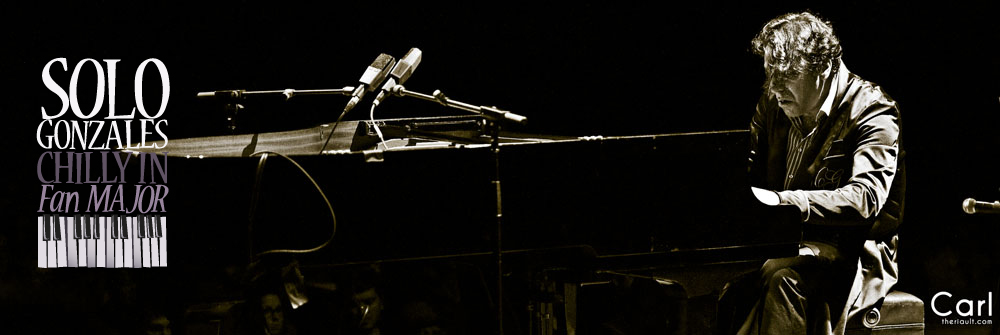 Gonzales’ recent article in The Guardian (Chilly Gonzales on musical tropes in 2014: when the chord progression died), examines the current trend of eschewing ‘traditional’ chord progressions and harmonic content in favour of a distinct and instantly identifiable ‘sound’. In a 2012 New Yorker article (The Song Machine), I was struck at how producers had to incorporate hooks into the intro, pre-chorus, chorus, and bridge, because artists only had 7 seconds of to ‘hook’ listeners. It’s possible that the introduction of a ‘sound’ attempts to mitigate the insatiable need for hooks in music, with a ‘sound’ for a song that would draw listeners in, but how did we ‘progress’ to this point? Gonzales’ article certainly struck a chord with readers, as feedback appeared swiftly. After reading the article and feedback a number of times, we wondered if there was a secondary, larger message within Gonzales view of the hits and musical trends of 2014.
Gonzales’ recent article in The Guardian (Chilly Gonzales on musical tropes in 2014: when the chord progression died), examines the current trend of eschewing ‘traditional’ chord progressions and harmonic content in favour of a distinct and instantly identifiable ‘sound’. In a 2012 New Yorker article (The Song Machine), I was struck at how producers had to incorporate hooks into the intro, pre-chorus, chorus, and bridge, because artists only had 7 seconds of to ‘hook’ listeners. It’s possible that the introduction of a ‘sound’ attempts to mitigate the insatiable need for hooks in music, with a ‘sound’ for a song that would draw listeners in, but how did we ‘progress’ to this point? Gonzales’ article certainly struck a chord with readers, as feedback appeared swiftly. After reading the article and feedback a number of times, we wondered if there was a secondary, larger message within Gonzales view of the hits and musical trends of 2014.
The democratization of creating books and art occurred a long time ago; we are the lucky recipients of centuries of artistic and literary evolution and refinement. Ancient artists built on each other’s techniques with the ultimate goal of photorealism, or at least a very good approximation of what ‘real life’ looked like at the time. While photorealistic painting has had a recent revival, in the late 1800s artists started to move towards more abstract forms of art. What caused this change? A large factor was the invention of the photograph. If photography democratized realism so that anyone could reproduce real-life, then it was time for artists to embed deeper meaning in their art though simplification. In 1990, the National Gallery of Canada spent $1.8M of taxpayer funds on a work of art by Barnett Newman called, The Voice of Fire (pictured above). The artwork consisted of three vertical stripes – two blue, and one red in the middle. People debated at length whether or not Newman’s piece was ‘art’ or something that a child could have created – much to the chagrin on the National Gallery (and possibly Newman’s ghost). At some point, reduction of art to the point where there is a fundamental debate as to what art is, brings up new and deeper meaning and appreciation to existing works, and possibly provides a spark of inspiration for future artists.
There have been musical corollaries to the Voice of Fire, with the extreme example being John Cage’s 4’33″, which consists of 4 minutes and 33 seconds of professional musicians not playing their instruments. The ‘music’ is whatever ambient noise the audience hears. In an odd modern twist, 4’33″ is available for purchase on iTunes (yes, it is a ‘silent’ track). Moving up the scale slightly is a song that Gonzales has referred to in concerts: Da Da Da by the German group Trio. While not quite as extreme as other minimalistic songs, Da Da Da is notable for selling over 13 million copies of a song that mainly consists of an arpeggiated Casio keyboard, simple drum track, and repetitive vocals – all highly unlikely elements for a 1982 hit song. Trio was part of a short-lived German musical movement called Neue Deutsche Welle (new German wave), which included influential acts such as Falco, Nena, and Klaus Nomi. The overall goal was to strip away all ornamentation and overproduction so the true nature of sound could come through. Was this a counter example to the logic of reductio ad absurdum – a song so absurdly simple that it would be rejected by the public? On the contrary, people loved the simplicity and accessibility of the song in contrast to the wall of sound that had dominated the punk landscape.
In Gonzales’ Guardian article, Gonzales points out that reduction has once again entered the musical landscape, but updated for modern ears through a removal of traditional chord progressions. People critical of the article point out that there are many, many more songs in 2014 that have traditional chord progressions. This is very true, but they aren’t at the top of the charts, and in terms of the widest musical influence, that’s what counts. If you read the article carefully, Gonzales isn’t criticizing the music at all, but rather instinctively breaking down the music into its mathematical components or building blocks and their relationship to one another and other songs and artists. If the article isn’t critical about current music, then what is Gonzales really trying to say?
While people are distracted by the catchy melody or visual appeal of a Swift or Azalea, the underlying mainstream musical culture imperceptibly changes and adapts. If today’s Top 40 is a point-in-time reflection of society, how did we arrive at this point? Have a look at the top songs of each year throughout history, and you’ll find a pattern that aligns with social, political, and economic cultures. Aside from the obvious monetary rewards, who wouldn’t want to play a part in ‘defining’ a generation? Doesn’t reaching millions of ‘unreachable’ young people carry more inherent power than a politician or business? The only people who can claim to come close to this level of influence are advertising agencies, and even their grip has loosened somewhat with the ever-shrinking captive TV audience.
But why do listeners ‘choose’ Swift, Jackson, Springsteen, Berry or Mozart? Conspiracy theorists would argue that the Illuminati control what we like, and we really don’t have a choice in what becomes popular. While large labels, payola and deep pockets certainly play a part in determining what we hear, music is ultimately a democratic and somewhat meritocratic business driven by sales. In order to sell product and make money, people have to like what they hear and part with their hard-earned money. If musical tastes change faster than ever before, it’s not only because listeners can consume more music faster and in more places than ever before, but also because the process of making and distributing music has been democratized. Technology allows many more people to pick up a (relatively) cheap portable device and try their hand at a making music. A million people hitting GarageBand long enough will create something that resonates with friends, a YouTube audience, a producer, and possibly a large segment of the population. That sound survives and lives not because of a hidden agenda, but because people like it, and being current with trends make many people feel as if they ‘fit’ in with today’s society and their peer group. As musicians try to grasp the elusive notion of the next ‘sound’, pop music twists and turns in a seemingly unpredictable fashion.
Let’s look at Gonzales’ own Solo Piano albums for a moment. His songs are played on an upright piano that can be purchased ‘off the shelf’ with a design that hasn’t fundamentally changed for hundreds of years. Given this ‘vanilla’ platform, what makes Gonzales’ style instantly identifiable? Think about how difficult of a task it is to take the limited sound of the piano and make music in a style that other people can recognize. That’s part of Gonzales’ appeal – painting music with traditional materials that are instantly accessible, touching, and recognizable, but will also withstand the test of time. From an art perspective, I never tire of looking at the Renoir print I have in the dining room. New details emerge in different lighting conditions, my state of mind, and even who is with me in the room. The original artworks that adorn the concrete warehouse of our local Ikea are interesting for a few months, but quickly disappear the longer you stare at them. It takes years of study and depth of character to create art that truly withstands the test of time. You can listen to a Gonzales solo piano song at this very moment and discover new things, while the same can’t generally be said for last year’s overplayed hits. His songs are endearing in an emotional way, which creates a far deeper attachment than a fleeting Maroon 5 chorus chant.
Everything humans have produced has been influenced by the time in which they were created, and the music of today is no different. Stone tools, pyramids, steam-powered machines, and computers, have all appeared on a continuum of change that is easy to map with hindsight, but only exists as a series of mostly imperceptible changes to the people living in the time. Gonzales’ article highlights the death of the chord progression, while celebrating the continued evolution of sound as a defining musical characteristic. Perhaps the deeper meaning in Gonzales’ article is not contained within the analysis of harmonies or melodies, but rather to have an appreciation and understanding of music as a unique lifeform. Music’s DNA consists of 12 tones, rhythm, and harmony expressed in countless musical ‘plants and animals’, which can adapt when faced with new challenges. Some species are successful for a very long time, while others appear and die off very quickly: music is dramatically influenced by its environment. Gonzales challenges us to understand and study the past and the present in order to better understand and appreciate (and possibly define) the future. In retrospect, will Fancy be heralded as a defining moment for a new musical movement? Probably not, but far from making music less enjoyable, an awareness of today’s music and its lineage increases our appreciation for its ability to reflect and shape society.
